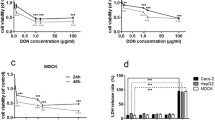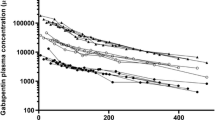Abstract
The objective of this study was to examine the effect of ion-pair complexation with endogenous bile salts on the transport of a quarternary ammonium organic cationic (OC) drug, berberine, across the Caco-2 and LLC-PK1 cell monolayers. The basolateral-to-apical (BL-AP) transport of berberine in Caco-2 cells was temperature dependent and 10-fold higher than that of the apical-to-basolateral (AP-BL) transport. Similar results were observed for the transport of berberine across the LLC-PK1 cells. Moreover, the BL-AP transport in the Caco-2 cells was significantly reduced by the cis-presence of P-glycoprotein (P-gp) inhibitors such as cyclosporine A, verapamil, and digoxin. These results suggest that an efflux transporter, probably P-gp, is involved in the Caco-2 cell transport. The Km and Vmax values for the carrier-mediated transport were estimated to be 83.4 mM and 7640 pmole/h/cm2, respectively. The apparent partition coefficient (APC) of berberine between n-octanol and a phosphate buffer (pH 7.4) was increased by the presence of an organic anion (OA), taurodeoxycholate (TDC, a bile salt), suggesting the formation of a lipophilic ion-pair complex between an OC (berberine) and an OA (TDC). Despite the ion-pair complexation, however, the BL-AP transport of berberine across the Caco-2 and LLC-PK1 cells was not altered by the cis-presence of bile salts or the rat bile juice. This is consistent with the reportedly unaltered secretory transport of a quarternary ammonium compound, tributylmethylammonium (TBuMA), across the Caco-2 cell monolayers in the cis-presence of bile salts or the rat bile juice, but not with our previous report in which the secretory transport of TBuMA across the LLC-PK1 cell was increased in the cis-presence of TDC. Therefore, the effect of ion-pair formation with the bile components or bile salts on the secretory transport of OCs appears to depend on the molecular properties of OCs (e.g., molecular weight, lipophilicity and affinity to relevant transporters) and the characteristics of cell strains (e.g., expression and contribution of responsible transporters to the transport).
Similar content being viewed by others
References
Artursson, P. and Karlsson, J., Correlation between oral drug absorption in humans and apparent drug permeability coefficients in human intestinal epithelial (Caco-2) cells. Biochem. Biophys. Res. Commun., 175, 880–885 (1991).
Chen, C. M. and Chang, H. C., Determination of berberine in plasma, urine and bile by high-performance liquid chromatography. J. Chromatogr. B Biomed. Appl., 665, 117–123 (1995).
Chiba, P., Holzer, W., Landau, M., Bechmann, G., Lorenz, K., Plagens, B., Hitzler, M., Richter, E., and Ecker, G., Substituted 4-acylpyrazoles and 4-acylpyrazolones: synthesis and multidrug resistance-modulating activity. J. Med. Chem., 41, 4001–4011 (1998).
Ckless, K., Schlottfeldt, J. L., Pasqual, M., Moyna, P., Henriques, J. A., and Wajner, M., Inhibition of in-vitro lymphocyte transformation by the isoquinoline alkaloid berberine. J. Pharm. Pharmacol., 47, 1029–1031 (1995).
Dressman, J. B., Amidon, G. L., Reppas, C., and Shah, V. P., Dissolution testing as a prognostic tool for oral drug absorption: immediate release dosage forms. Pharm. Res., 15, 11–22 (1998).
Gaginella, T. S., Bass, P., Perrin, J. H., and Vallner, J. J., Effect of bile salts on partitioning behavior and Gl absorption of a quaternary ammonium compound, isopropamide iodide. J. Pharm. Sci., 62, 1121–1125 (1973).
Kalantzi, L., Goumas, K., Kalioras, V., Abrahamsson, B., Dressman, J. B., and Reppas, C., Characterization of the human upper gastrointestinal contents under conditions simulating bioavailability/bioequivalence studies. Pharm. Res., 23, 165–176 (2006).
Kaneda, Y., Torii, M., Tanaka, T., and Aikawa, M., In vitro effects of berberine sulphate on the growth and structure of Entamoeba histolytica, Giardia lamblia and Trichomonas Vaginalis. Ann. Trop. Med. Parasitol., 85, 417–425 (1991).
Klopman, G. and Zhu, H., Recent methodologies for the estimation of n-octanol/water partition coefficients and their use in the prediction of membrane transport properties of drugs. Mini Rev. Med. Chem., 5, 127–133 (2005).
Lee, H. K., Chien, Y. W., and Lin, T. K., Functional group contribution of bile salt molecules to partitioning of a quaternary ammonium N,N-dimethyl derivative of propranolol. J. Pharm. Sci., 67, 847–849 (1978).
Li, H., Chung, S. J., Kim, D. C., Kim, H. S., Lee, J. W., and Shim, C. K., The transport of a reversible proton pump antagonist, 5, 6-dimethyl-2-(4-Fluorophenylamino)-4-(1-methyl-1,2,3, 4-tetrahydroisoquinoline-2-yl) pyrimidine hydrochloride (YH1885), across caco-2 cell monolayers. Drug. Metab. Dispos., 29, 54–59 (2001).
Maeng, H. J., Yoo, H. J., Kim, I. W., Song, I. S., Chung, S. J., and Shim, C. K., P-glycoprotein-mediated transport of berberine across Caco-2 cell monolayers. J. Pharm. Sci., 91, 2614–2621 (2002).
Neubert, R., Ion pair transport across membranes. Pharm. Res., 6, 743–747 (1989).
Pan, J. F., Yu, C., Zhu, D. Y., Zhang, H., Zeng, J. F., Jiang, S. H., and Ren, J. Y., Identification of three sulfate-conjugated metabolites of berberine chloride in healthy volunteers’ urine after oral administration. Acta. Pharmacol. Sin., 23, 77–82 (2002).
Sheng, M. P., Sun, Q., and Wang, H., Studies n the intravenous pharmacokinetics and oral absorption of berberine HCl in beagle dogs. Chin. Pharmacol. Bull., 9, 64–67 (1993).
Shim, C. K., Nishigaki, R., Iga, T., and Hanano, M., Determination of extraction coefficient, true partition coefficient and formation constant of ion-paring complexes of quaternary ammonium salts, tetrabutylammonium bromide and isopropamide iodide with some organic anions by a solvent extraction technique. Int. J. Pharm., 8, 143–151 (1981).
Shim, C. K., Chung, S. J., Lee, J. U., Lee, M. H., and Kim, S. K., Effect of bile salt on the pharmacokinetics of bretylium in the rat (I): increased lipophilicity of bretylium by ion-pair complexation with taurodeoxycholate. Arch. Pharm. Res., 9, 111–114 (1986).
Shitan, N., Tanaka, M., Terai, K., Ueda, K., and Yazaki, K., Human MDR1 and MRP1 recognize berberine as their transport substrate. Biosci. Biotechnol. Biochem., 71, 242–245 (2007).
Song, I. S., Chung, S. J., and Shim, C. K., Contribution of ion pair complexation with bile salts to biliary excretion of organic cations in rats. Am. J. Physiol. Gastrointest Liver. Physiol., 281, G515–G525 (2001).
Song, I. S., Han, Y. H., Chung, S. J., and Shim, C. K., Contribution of ion-pair complexation with bile salts to the transport of organic cations across LLC-PK1 cell monolayers. Pharm. Res., 20, 597–604 (2003).
Taylor, C. T., Winter, D. C., Skelly, M. M., O’Donoghue, D. P., O’sullivan, G. C., Harvey, B. J., and Baird, A. W., Berberine inhibits ion transport in human colonic epithelia. Eur. J. Pharmacol., 368, 111–118 (1999).
Torok, M., Gutmann, H., Fricker, G., and Drewe, J., Sister of P-glycoprotein expression in different tissues. Biochem Pharmacol., 57, 833–835 (1999).
Tsai, P. L. and Tsai, T. H., Hepatobiliary excretion of berberine. Drug Metab. Dispos., 32, 405–412 (2004).
Van Gelder, J., Witvrouw, M., Pannecouque, C., Henson, G., Bridger, G., Naesens, L., De Clercq, E., Annaert, P., Shafiee, M., Van den Mooter, G., Kinget, R., and Augustijns, P., Evaluation of the potential of ion pair formation to improve the oral absorption of two potent antiviral compounds, AMD3100 and PMPA. Int. J. Pharm., 186, 127–136 (1999).
Zamora, J. M., Pearce, H. L., and Beck, W. T., Physical-chemical properties shared by compounds that modulate multidrug resistance in human leukemic cells. Mol. Pharmacol., 33, 454–462 (1988).
Zhang, L., Gorset, W., Dresser, M. J., and Giacomini, K. M., The interaction of n-tetraalkylammonium compounds with a human organic cation transporter, hOCT1. J. Pharmacol. Exp. Ther., 288, 1192–1198 (1999).
Author information
Authors and Affiliations
Corresponding author
Rights and permissions
About this article
Cite this article
Chae, HW., Kim, IW., Jin, HE. et al. Effect of ion-pair formation with bile salts on the in vitro cellular transport of berberine. Arch. Pharm. Res. 31, 103–110 (2008). https://doi.org/10.1007/s12272-008-1127-4
Received:
Published:
Issue Date:
DOI: https://doi.org/10.1007/s12272-008-1127-4




